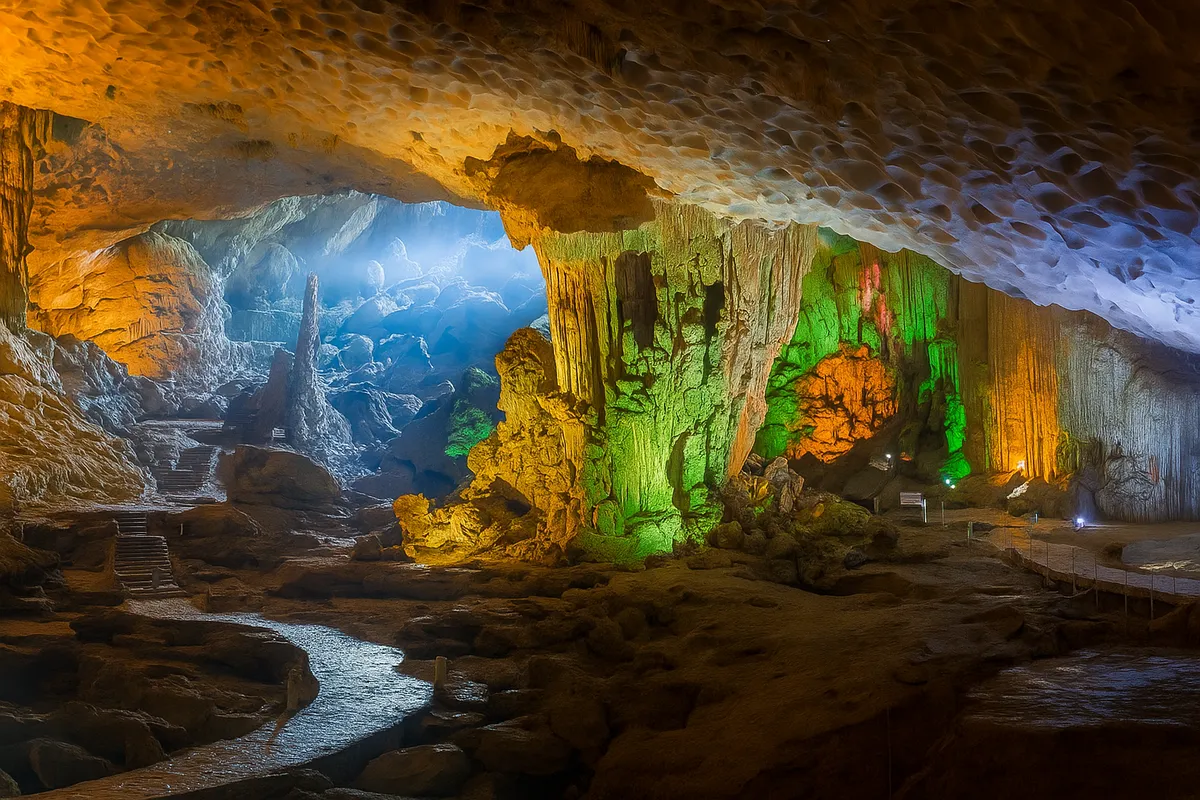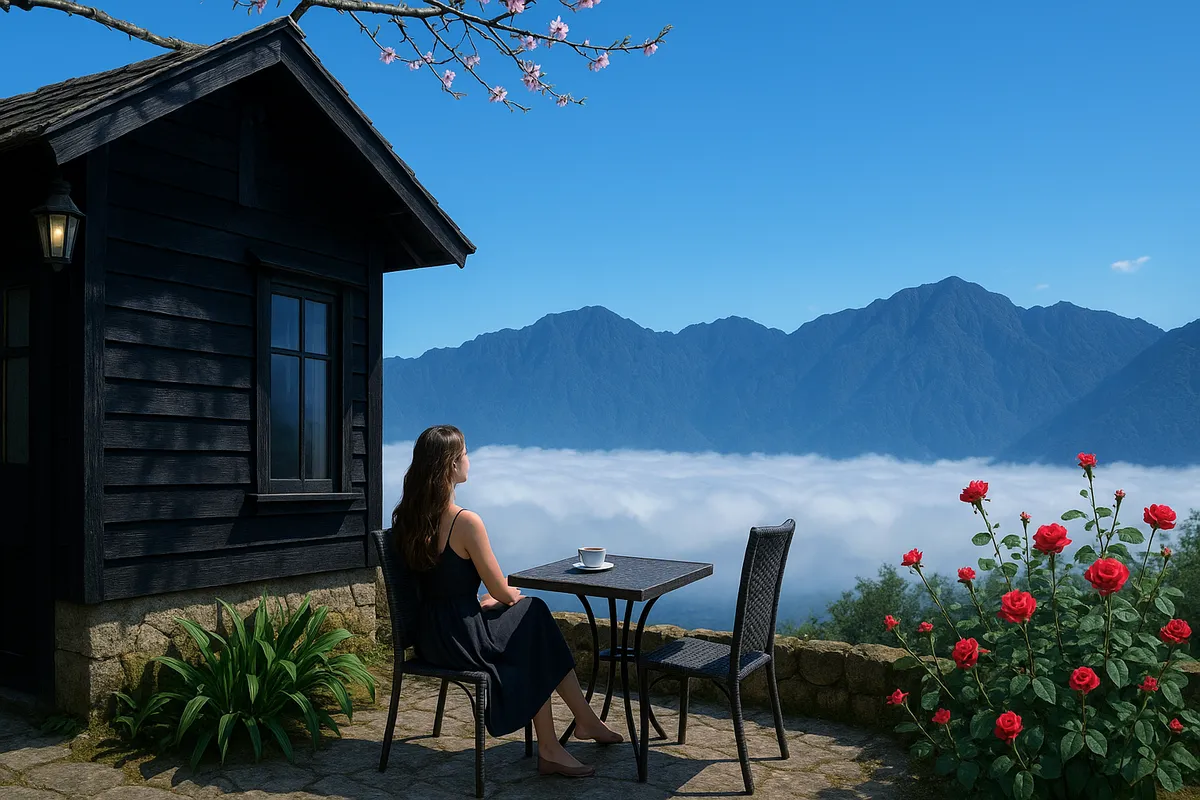Dau Go Cave and the thousand-year-old secrets in Ha Long
- Tuesday, Jun 24, 2025, 18:25 (GMT+7)
Dau Go Cave and the thousand-year-old secrets in Ha Long
Dau Go Cave rests silently in the heart of Ha Long Bay, like a low and lingering note in the grand symphony of sky and sea. Its name may sound plain at first, but it hides an entire universe of wonder, where each droplet that falls from the cave’s ceiling seems to awaken an ancient call from the depths of time. Unlike other tourist destinations dulled by too many footsteps, this place preserves the untouched beauty of a legend that has never stopped dreaming.
As the boat slices through rippling jade waters and weaves between craggy islets that resemble petrified fish rising from the sea, a shadowed arch emerges ahead. Dau Go Cave reveals itself with a wide, towering entrance that opens like a gateway into another world. Wind slips through crevices damp with moss, carrying the earthy scent of time and an echo that feels like a whisper from the underworld. Light spills through the cave’s opening and dances across stone pillars arranged like dancers frozen mid-movement, waiting for the music to resume. One rock formation swells like an ancient bell that needs only the gentlest touch to release sound in ripples. Another curves like a turtle’s back, weathered and silent as if dreaming inside a forgotten story.
The cave unfolds in three chambers, each a world of its own. The first glows with natural light, where nature has shaped stone into mythical creatures: a pair of fighting cocks, a lion mid-roar, a python coiled in eternal slumber. Light and shadow blend like ink and water, giving the formations a sense of motion, as though they breathe. Moving through a narrow passage into the second chamber, the atmosphere quiets as if someone had drawn all sound away. Stone towers rise like temples veiled in mist, ancient columns unnamed and silent, guarding secrets untold. Then comes the final chamber, vast and high like the vaulted ceiling of a forgotten cathedral. Light threads through narrow gaps, falling onto a still, round pool deep within the cave. Its surface is glassy and clear, like a mirror reflecting the passage of millennia.
According to old tales, during the resistance against Mongol invaders in the thirteenth century, General Tran Hung Dao hid sharpened ironwood stakes in this very cave. These stakes later helped create the legendary victory at the Bach Dang River. Though many of the wooden remnants have faded with time, traces are said to linger in the shadows, bearing witness in silence. Originally known as the Cave of Hidden Wood, the name slowly transformed into Dau Go Cave. Another legend suggests the name came from an island at the cave’s mouth that resembles a giant block of wood with holes at both ends to anchor ropes. Whether fact or folklore, every interpretation adds another layer to the cave’s identity, turning it into a living manuscript that history continues to write.
The world took notice of Dau Go Cave early on. In 1917, Emperor Khai Dinh visited the cave with the Governor General of Indochina and had verses carved into the stone walls, praising its natural grandeur. Decades later, a French magazine named it one of the greatest wonders of the East. And few know that in 1962, President Ho Chi Minh also stopped by the cave on a cruise through the bay. He lingered by the underground pool for a long moment. That moment is now woven into the cave’s legacy, remembered like a sacred breath between the stones.
What makes this cave unlike any other in Ha Long Bay is its thriving internal ecosystem. While many caves are dry and polished smooth, Dau Go Cave, thanks to its humidity and multiple light sources, supports a miniature forest within. Moss blankets the ancient stone steps. Ferns hang and sway with every breeze. Small trees sprout from cracks in the limestone. It feels as if the jungle had quietly taken root in a secret chamber. To stand in the cold of the stone and still be surrounded by greenery is to witness nature holding its breath and smiling.
From the city of Ha Long, the journey to Dau Go Cave feels like a gentle descent into a dream. After a short thirteen kilometer drive to Tuan Chau harbor, a boat ride on one of the classic bay routes brings you past iconic islets like the Kissing Rocks and the Stone Dog, until the cave comes into view. Those who arrive early in the day will see light pouring into the cave like soft silk. Others who visit late in the afternoon will catch the cave as it turns indigo under the twilight, a transformation so subtle it feels like alchemy. Every hour here offers a different portrait, none the same, none to be forgotten.
Between April and August, the cave shines brightest. But during the quieter rains of October, when mist drapes over the stone like a thin veil, the entire space becomes surreal. Each sound becomes sacred. A drop falling into the pool echoes like a bell from another realm. The wingbeat of a bat in the distance feels like a page turning. Every footstep reverberates through the silence like a respectful question posed to time itself.
Few have witnessed it, but on special occasions, musicians have played inside the cave. No microphones, no lights, no stage. Just a violin or a bamboo flute and the natural acoustics of the limestone walls. The sound rises, folds, and returns like a spirit awakened. Audience members sit on mossy stone platforms, watching as golden beams flicker through the cave like ancient candlelight. The performance becomes something more than music. It is communion.
Stepping out of the cave into the bright sunlight can be startling, as if one had left another dimension. The bay, calm and still, reflects the boat’s shadow like a ribbon drifting across the water. It is in that moment, as the sound of the cave recedes into memory, that the wonder truly sinks in. What just happened was not a tour. It was a journey through silence, texture, story, and song.

 CHECKIN.VN
CHECKIN.VN








Share on